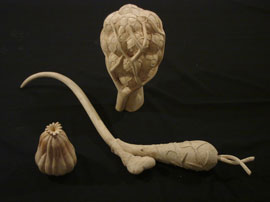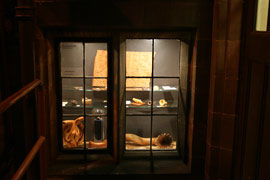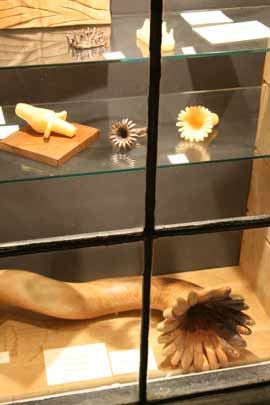16th March - 16th April 2010
Rosemary Terry
Botanatomica
Having long been inspired by a perception of a ‘commonality of form’ between human artefacts and forms found in nature, I’m grateful for the chance provided by the Gallery of Wonder to put this theory to the test in a different way.
Leafing through a recent, lavishly illustrated publication on human anatomy, I was struck for the first time by the many resemblances between the microscopic forms and structures buried deep within the human body and those of other forms in nature. It seemed as if our ancestry in nature is written into our bodies in microscopic form – evidence if any were needed of our total dependency on and integration into the other orders and species on earth on every scale- from bacteria to redwoods.
This connection is revealed in our daily terminology –trees have ‘trunks’, ‘limbs’, ‘crowns’, a human hair has a ‘bulb’ and a ‘root’, the intricate structure of the cerebellum at the base of the human brain is termed the ‘arbor vitae’, tree of life. The language as a whole is sprinkled with such references to nature whose forms and structures were there first. But although we all unconsciously acknowledge this vital connection in using the language, our conscious awareness of our place within nature is practically non-existent. Or it might be truer to say, we know it intellectually but lack an emotional, imaginative or cultural engagement with that knowledge. The result of this severance is unfolding before us at alarming speed.
Botanatomica is a body of work which aims to draw attention to this perceived ‘commonality of form’ which unites our bodies with the humble forms of nature. Scaled-up versions of microscopic forms, plucked from their anatomical context, may enable them to be seen afresh, if not for the first time, and herein lies the wonder. How many of us recognise the form and structure of our own hair, or lung, or eye?
Carving in wood has a kinship with surgery – cutting into the material to uncover form. The wood itself could represent nature, or specifically trees with which we humans have a vital symbiotic relationship, or simply a medium , common in museums, to explain forms and systems through models. The question may arise as to the status of these carvings, and the bronze and wax objects accompanying them – models? fragments? relics? specimens? The woods used are all hardwoods native to Britain since the last Ice Age, so represent some of the species whose presence has provide our oxygen for 10,000 years.
The labelling uses a creative taxonomy to identify the anatomical form with the wood used, and to promote uncertainty about the form’s origin – plant? human? The Latin taxonomy identifies the tree species in the genitive case – in other words, the anatomy can be interpreted as belonging to that species – e.g. hair of oak, lung of lime, etc. For if the first taxonomists could observe, record and compare natural phenomena across plant and animal species with accuracy and truth, cannot we who inherit their findings rediscover a capacity to observe and wonder at nature both within and without?
‘If human beings are irredeemably part of the whole system of the world, if everything that happens inside us is ultimately a manifestation of what lies behind everything that happens outside us, then we cannot abstract ourselves from the world; we cannot place ourselves outside or above nature, since we are locked into its fabric. This means, in essence, that everything we do to nature, we ultimately do to ourselves, above all in the sense that if we brutalize one of Nature’s creations, we brutalize ourselves .’
1 Martin Kemp, ‘Seen/Unseen : Art, Science and Intuition from Leonardo to the Hubble Telescope’ Oxford, 2006, p. 92
Rosemary Terry.
February 2010
Biography: Rosemary Terry studied Sculpture at Norwich School of Art and UCE Birmingham. In 1998 she was appointed 0.5 Lecturer at University of Wolverhampton School of Art and Design. She has exhibited widely in the UK, including a solo show at the Laing Gallery Newcastle in 1999, undertaken many public art commissions and participated in international symposia in Russia and Wales. She has work on permanent display at Lake Vyrnwy International Sculpture Park in mid-Wales. She is currently an external examiner for the Combined Studies Drawing module in the Fine Art area at Newcastle.




